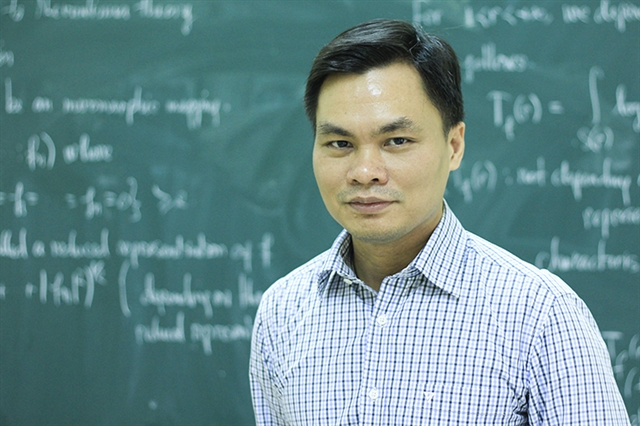 Inner Sanctum
Inner Sanctum

Sĩ Đức Quang, 38, from the Hà Nội National University of Education, was the youngest person to become a professor in Viet Nam this year. The maths professor talks with Hà Nguyễn about his upbringing and his love for maths.

|
Sĩ Đức Quang, 38, from the Hà Nội National University of Education, was the youngest person to become a professor in Viet Nam this year. The maths professor talks with Hà Nguyễn about his upbringing and his love for maths.
Inner Sanctum: You were a talented literature student, so how did you end up researching maths?
I have been interested in mathematics since I started reading the Journal of Mathematics and Youth in 1997. The mathematical stories and problems attracted me by their beauty, creativity and challenging nature.
When I was a student, after learning advanced mathematics, I saw this subject is not only beautiful but also contains philosophy. One of the most important reasons for my interest in mathematics is that this subject is the basis for almost all other natural scientific subjects. I see researching mathematics as really meaningful work.
Inner Sanctum: How did you go about mastering mathematics?
When I was a student at high school, first I learned in detail the knowledge in the high school syllabus, and then tried to find articles on fundamental mathematics to learn more.
I do not consider solving difficult exercises as the most important thing. For me, understanding the nature inside the problems and knowledge is the most important.
When I was a student at university, besides the syllabus of the university, I found and read mathematical monographs, papers and joined some seminars on topics I was interested in.
Inner Sanctum: Did your parents encourage you to pursue maths?
I was born into a poor family. My family had to move many times for work. My parents always supported me to learn and study but never forced me to choose a particular subject. They respect my choice of subject for deep learning.
The times I remember most from back then are when I used to study until midnight in a shack outside the house and every time my mum also stayed up to look after me.
Inner Sanctum: How did you react when you received a scholarship to Japan’s Tokyo University for your doctoral thesis?
I was very happy when I received a scholarship to Tokyo University for doing my PhD. It was my dream when I was a student at university, especially to do a PhD under the guidance of Prof. Junjiro Noguchi, a mathematician I greatly respect.
Perhaps, my supervisor would now say I am a hard-working and honest person.
Inner Sanctum: Local and foreign maths professors including Pro. Đỗ Đức Thái from HNUE and Associate Prof. Tạ Thị Hoài An from the Institute of Mathematics have praised your research. Could you tell us about your project's contributions to the development of Nevanlinna theory and its applications in daily life ?
I am researching Nevanlinna theory, which lies at the intersection of complex geometry, complex analysis and number theory.
My research focuses on establishing the second main theorem (which is the most important question in Nevanlinna theory) and the application of this theory in some related problems in mathematics.
My most important contribution to the development of this theory is that I have had success in establishing the degeneracy second main theorem for meromorphic mapping into projective variety with a family of hypersurfaces in subgeneral position and in establishing second main theorem with good truncated counting function for moving hyperplanes.
As I said, this theory lies at the intersection of some large subjects in mathematics, therefore it has many applications to many other problems in pure mathematics.
I have not yet applied this theory for any problem in daily life. But I know this theory can be also applied mathematics.
For instance, in the paper 'The Nevanlinna theory and its related Paley problems with applications in infinite-dimensional spaces (Complex Variables and Elliptic Equations Vol. 56, Nos. 1–4, January–April 2011, 299–314)' of Professor C.G. Hu, the author presents the applications of Nevanlinna to some applied mathematical subjects in control theory, some of them had been applied to predict an earthquake.
He wrote: "As an illustration of the method, the short-term precursory anomalies in short-range levelling of Dahuichang and in underground water levels of Shuangqiao and Hangu before Tangshan earthquake in China (M = 7.8) in July 1976 were detected clearly."
Hence, sometimes we do not know exactly when pure mathematics can be applied to daily life’s problems.
Inner Sanctum: You are still young but many of your projects have been introduced in international maths journals and newspapers. Can you tell us about these publications?
I have had a number of papers published in international journals. All of them focus on Nevanlinna theory. I started writing the first paper when I was a third year student at university, in 2001.
Inner Sanctum: What are your plans for the future? Do you plan to train new maths talents in Việt Nam ?
Training new maths talents in Việt Nam is one of my most important tasks and also my favourite.
I hope I can give more lectures to gifted high school students and university students and talk with them about mathematics and the meaning of mathematics.
I hope I can help students find scholarships and funds for further mathematical research, and help them contact mathematics institutes overseas and also suggest they start doing mathematics.VNS